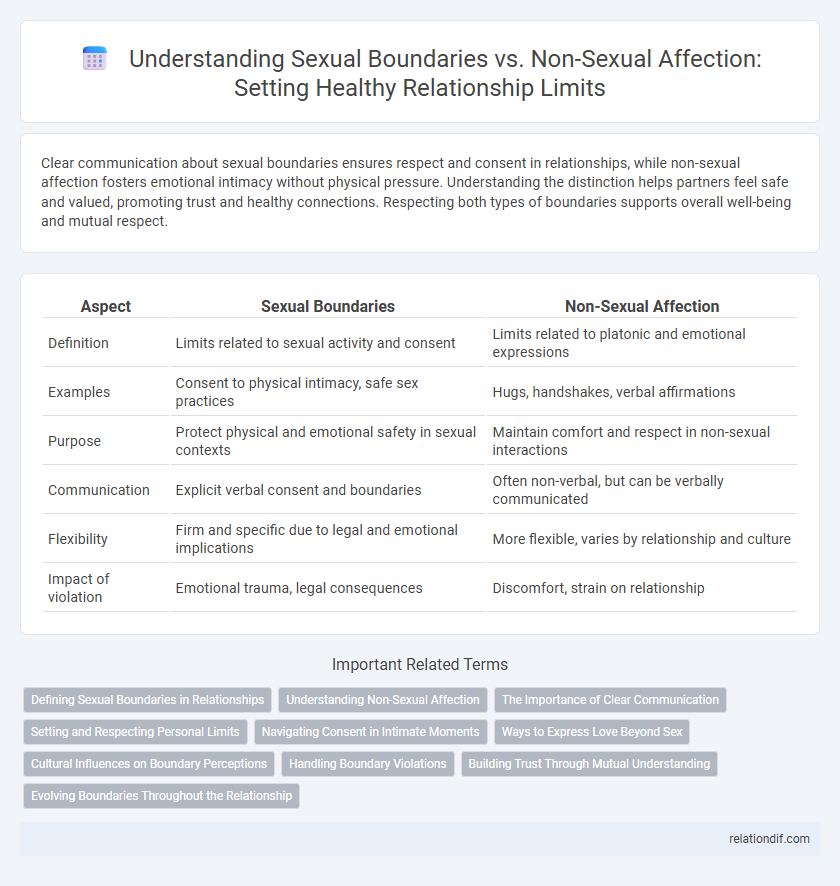Clear communication about sexual boundaries ensures respect and consent in relationships, while non-sexual affection fosters emotional intimacy without physical pressure. Understanding the distinction helps partners feel safe and valued, promoting trust and healthy connections. Respecting both types of boundaries supports overall well-being and mutual respect.
Table of Comparison
| Aspect | Sexual Boundaries | Non-Sexual Affection |
|---|---|---|
| Definition | Limits related to sexual activity and consent | Limits related to platonic and emotional expressions |
| Examples | Consent to physical intimacy, safe sex practices | Hugs, handshakes, verbal affirmations |
| Purpose | Protect physical and emotional safety in sexual contexts | Maintain comfort and respect in non-sexual interactions |
| Communication | Explicit verbal consent and boundaries | Often non-verbal, but can be verbally communicated |
| Flexibility | Firm and specific due to legal and emotional implications | More flexible, varies by relationship and culture |
| Impact of violation | Emotional trauma, legal consequences | Discomfort, strain on relationship |
Defining Sexual Boundaries in Relationships
Defining sexual boundaries in relationships involves clear communication about personal comfort levels, consent, and mutual respect regarding physical intimacy. Establishing these boundaries helps distinguish between sexual activities and non-sexual affection, ensuring both partners feel safe and respected. Understanding individual limits fosters trust and prevents misunderstandings, promoting a healthy emotional and physical connection.
Understanding Non-Sexual Affection
Understanding non-sexual affection involves recognizing gestures like hugs, hand-holding, or gentle touches that convey care without romantic or sexual intent. Maintaining clear sexual boundaries ensures these expressions remain comfortable and respectful for all parties involved. Respecting each individual's defined limits fosters trust and emotional safety within relationships.
The Importance of Clear Communication
Clear communication is essential in distinguishing sexual boundaries from non-sexual affection, ensuring mutual understanding and respect in relationships. Defining personal limits and expressing comfort levels helps prevent misunderstandings and fosters trust between partners or friends. Consistently articulating these boundaries promotes a safe environment where all parties feel valued and secure.
Setting and Respecting Personal Limits
Setting and respecting personal limits involves clearly communicating sexual boundaries to ensure mutual consent and comfort during intimate interactions. Non-sexual affection requires recognizing individual preferences for touch and emotional closeness, promoting trust without overstepping physical or emotional limits. Establishing these distinctions helps maintain healthy relationships by honoring each person's autonomy and emotional safety.
Navigating Consent in Intimate Moments
Navigating consent in intimate moments requires clear communication and respect for both sexual boundaries and non-sexual affection. Establishing verbal and non-verbal cues helps partners understand comfort levels, ensuring affectionate gestures like hugging or hand-holding align with personal limits. Recognizing and honoring these distinctions fosters trust and emotional safety in relationships.
Ways to Express Love Beyond Sex
Expressing love beyond sex involves actions like verbal affirmations, thoughtful gestures, and consistent emotional support that respect individual sexual boundaries. Non-sexual affection includes activities such as holding hands, hugging, spending quality time, and sharing interests, which foster intimacy without physical pressure. Prioritizing clear communication and mutual consent ensures both partners feel valued and secure while strengthening emotional connections.
Cultural Influences on Boundary Perceptions
Cultural influences significantly shape perceptions of sexual boundaries and non-sexual affection, with varying norms dictating acceptable behaviors and expressions of intimacy across societies. In some cultures, physical touch such as hugging or holding hands is common and non-sexual, whereas in others, even non-sexual affection is closely regulated to maintain propriety. Understanding these cultural contexts is essential for respectful interpersonal interactions and effective communication about boundaries.
Handling Boundary Violations
Handling boundary violations requires clear communication when sexual boundaries are crossed, emphasizing consent and respect to restore trust. Non-sexual affection boundaries can be addressed by calmly expressing discomfort and reinforcing personal limits without escalating conflict. Consistent boundary-setting and active listening help maintain healthy relationships while preventing future violations.
Building Trust Through Mutual Understanding
Establishing clear sexual boundaries while respecting non-sexual affection fosters a foundation of trust essential for healthy relationships. Mutual understanding of each partner's comfort zones enhances emotional intimacy and reduces miscommunication. Prioritizing open dialogue about these boundaries builds security and reinforces respect in both physical and emotional expressions.
Evolving Boundaries Throughout the Relationship
Sexual boundaries and non-sexual affection often evolve as a relationship deepens, reflecting growing trust and comfort between partners. Clear communication helps partners negotiate changes in intimacy levels, ensuring mutual respect for individual limits. Recognizing and adapting to these shifting boundaries supports a healthy, balanced connection over time.
sexual boundaries vs non-sexual affection Infographic

 relationdif.com
relationdif.com